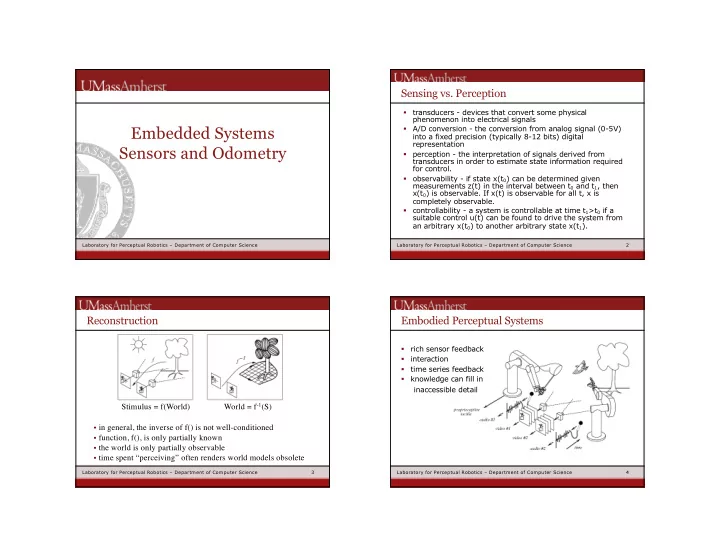

Sensing vs. Perception transducers - devices that convert some physical § phenomenon into electrical signals Embedded Systems A/D conversion - the conversion from analog signal (0-5V) § into a fixed precision (typically 8-12 bits) digital representation Sensors and Odometry perception - the interpretation of signals derived from § transducers in order to estimate state information required for control. observability - if state x(t 0 ) can be determined given § measurements z(t) in the interval between t 0 and t 1 , then x(t 0 ) is observable. If x(t) is observable for all t, x is completely observable. controllability - a system is controllable at time t 1 >t 0 if a § suitable control u(t) can be found to drive the system from an arbitrary x(t 0 ) to another arbitrary state x(t 1 ). Laboratory for Perceptual Robotics – Department of Computer Science Laboratory for Perceptual Robotics – Department of Computer Science 2 Reconstruction Embodied Perceptual Systems rich sensor feedback § interaction § time series feedback § knowledge can fill in § inaccessible detail Stimulus = f(World) World = f -1 (S) • in general, the inverse of f() is not well-conditioned • function, f(), is only partially known • the world is only partially observable • time spent “perceiving” often renders world models obsolete Laboratory for Perceptual Robotics – Department of Computer Science 3 Laboratory for Perceptual Robotics – Department of Computer Science 4
Sensor Drivers and Interface Circuitry Light Sensors - Photoresistor photosensors, micro switches, microphones, pyroelectric, near IR reflectance, sonar, strain gauges, gyroscopes, accelerometers, force, compasses, vision,... sensitivity S - a property of the transducer and describes § the D x (physical quantity) that is required to produce a D r (change in response)... voltage divider V signal = (5V) R R /(R + R R ) S = D x/ D r • choose R=R R when ambient light is midrange • Cadmium Sulfide (CdS) range, R - the range in the observable quantity x that § • cheap maps onto the 0-5 V transducer output resolution - the smallest D x that can be observed, i.e., § R/255 (linear transducer and 8-bit A/D). Laboratory for Perceptual Robotics – Department of Computer Science 5 Laboratory for Perceptual Robotics – Department of Computer Science 6 Light Sensors - Phototransistor Active Sensors - Pyroelectric Sensors lithium tantalate crystal is heated by thermal radiation § inducing charge tuned to 8-10 µ m radiation - respond to human IR § signature motion detecting burglar alarm § Eltec 442-3 sensor - two elements, Fresnel optics, § greater sensitivity output proportional to the difference between the charge on the left crystal and the charge on the right crystal. Laboratory for Perceptual Robotics – Department of Computer Science 7 Laboratory for Perceptual Robotics – Department of Computer Science 8
Quadrature Encoder Other Common Sensor Technologies Force strain gauges - foil, conductive ink • piezoelectric films • conductive rubber • capacitive force • rheostatic fluids • Sound Proprioceptive microphones • battery-level • • motor current - stall, external sonar (ping) • force Position • temperature microswitches • shaft encoders • Vision gyros • tilt/compasses • Laboratory for Perceptual Robotics – Department of Computer Science 9 Laboratory for Perceptual Robotics – Department of Computer Science 13 Interupt Handling with Arduino int pin = 13; volatile int state = LOW; void setup(){ pinMode(pin, OUTPUT); //specify pin 13 as output attachInterrupt(0, blink, CHANGE); // the number of the interrupt (int) [interrupt 0 takes inputs from digit input port 2] // when the interrupt occurs call the blink function; // a constant (CHANGE) defines how the interrupt is triggered. } LOW to trigger the interrupt whenever the pin is low, CHANGE to trigger the interrupt whenever the pin changes value void loop(){ RISING to trigger when the pin goes from low to high, digitalWrite(pin, state); FALLING for when the pin goes from high to low. } void blink(){ state = !state; } Laboratory for Perceptual Robotics – Department of Computer Science 14
Recommend
More recommend